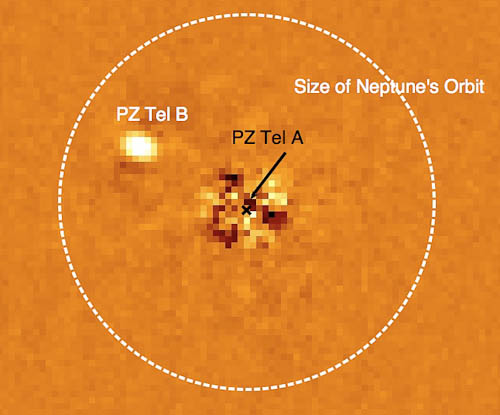Was it really three years ago that New Horizons moved past Jupiter, returning images of its stunning systems of storms and cloud? The mission continues to go well, and the photo below, taken by the spacecraft’s Long Range Reconnaissance Imager (LORRI) paints an unusual portrait of Jupiter and two of its largest moons from a distance of more than 16 AU, looking back toward the inner system. Note how faint the moons are, the consequence of the fast shutter speed used, with an exposure time of 0.009 seconds. I like what mission principal investigator Alan Stern says:
“This haunting image of Jupiter – far in the distance back in the Sun’s warmer clines from whence New Horizons came – reminds us of Voyager’s family postcard of the planets taken from beyond Neptune’s orbit about 20 years ago. Perhaps after we flyby Pluto in 2015, we’ll try something similar from our perch aboard New Horizons.”

Image: The New Horizons team looked back at Jupiter during Annual Checkout (ACO) 4 to test the Long Range Reconnaissance Imager (LORRI)’s ability to image targets close, in angle, to the Sun. This image was taken on June 24, when New Horizons was 16.3 astronomical units (about 1.5 billion miles) from Jupiter, at a spacecraft-Sun-planet angle of only 17 degrees. Looking like Earth’s moon at a quarter phase, Jupiter is clearly resolved, with an apparent diameter of nearly 12 LORRI pixels. LORRI also picks up the moons Ganymede and Europa, even though the exposure time was only nine milliseconds and these Galilean satellites are extremely faint in comparison to Jupiter. Credit: NASA/Johns Hopkins University Applied Physics Laboratory/Southwest Research Institute.
Meanwhile, looking at gas giants from any angle reminds me of the progressive escalation from planet to brown dwarf to star, especially in light of the new find — a 36 Jupiter-mass companion — around the star PZ Tel A. The object is a brown dwarf separated by about 18 AU from the star, a distance similar to that between the Sun and Uranus. That’s a tight separation given that the brown dwarf was discovered through direct imaging, where orbital separations greater than 50 AU are the more likely outcome.
PZ Tel B is evidently on a highly eccentric orbit — Beth Biller (University of Hawaii), lead author on the paper on this work, says ‘in the last ten years, we have literally watched it careen through its inner solar system’ — and images as recent as seven years ago show it obscured by the glare of its primary, an indication it is moving outward quickly from the star. Its orbital motion has implications for the kinds of planets that can form in such a system.

Image: PZ Tel A and B. The vast majority of light from PZ Tel A has been removed from this image using specialized image analysis techniques. The size of the orbit of Neptune is shown for comparison; PZ Tel B would lie within Neptune’s orbital dimensions and is one of the few brown dwarfs or exoplanets imaged at a distance of < 30 AU from its parent star. Credit: Beth Biller and the Gemini NICI Planet-Finding Campaign, Gemini Observatory/AURA. PZ Tel A is a young, Sun-like star about twelve million years old, still surrounded by significant amounts of circumstellar dust. Sifting a brown dwarf out of its glare is remarkable work, using adaptive optics coupled to the Near-Infrared Coronagraphic Imager (NICI), which can detect companions a million times fainter than the host star at 1 arcsecond separations. The science fiction writers among us can now go to work imagining what a similar brown dwarf would be like in our own system, and how it might affect a nearby civilization's thoughts on expanding into space. More can be found in the paper, which is Biller et al., "The Gemini NICI Planet-Finding Campaign: Discovery of a Close Substellar Companion to the Young Debris Disk Star PZ Tel," slated for publication in Astrophysical Journal Letters and available as a preprint.



Do we have any measurement that indicates how close to the primary PZ Tel B approaches at its periastron?
As a sloppy eyeball-estimate using the image, the occlusion area appears to be about a third of the total separation, with the separation given as 18 AU. The object is described as being “hidden in the glare” seven years ago, suggesting that it certainly approaches within 6 AU, and presumably closer.
Sounds like this is going to be one seriously disrupted circumstellar dust disk, with nothing in terms of stable orbits well past the apastron distance of PZ Tel B.
How far from us is PZ Tel A? Since this is a young system, will the orbit of the brown dwarf possibly become more circular in the future? Could this brown dwarf act like a Jupiter and keep stellar debri away from any new planets forming around 1AU safe? Just a few questions that came to mind.
Thanks, danangel@skybest.com
Istvan: I don’t see a periastron estimate for PZ Tel B in the paper, I’m afraid, though I’ve only had the chance to skim it so far.
Dan: PZ Tel A is approximately 168 light years from us. As to circularizing PZ Tel B’s orbit, I think it’s too early to say because from what I can see in the paper, quite a lot of work remains to be done in getting its current orbital properties nailed down.